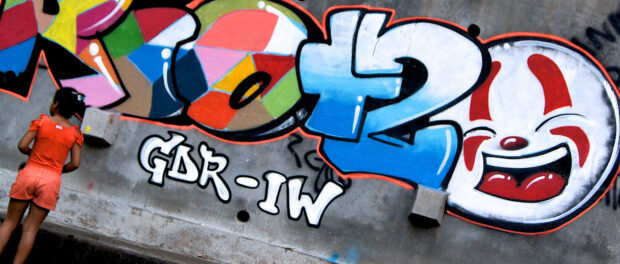
Marcos Rodrigo, also known as ‘Wark da Rocinha’ has been the favela’s premier graffiti artist for ten years now. The Rocinha native pioneered the graffiti movement in Brazil’s largest favela, which has garnered him attention and handshakes from prominent Brazilian leaders including Lula da Silva, Brazil’s former president. Wark also holds frequent exhibitions in the city and his commissioned works command thousands of Reais.
Two years ago, the graffiti artist decided to give back to the younger members of his community, so he founded Instituto Wark, a school for youth in Rocinha to learn and practice art-making. With his students, Wark creates public graffiti pieces that showcase the achievements of the community.
His students are on their way to becoming prominent graffiti artists as well. Marcos Brunno Werneck, one of Wark’s students even before Instituto Wark was created, has been leading his own graffiti classes and even expanding the model to other parts of Rio. Thayná Rodrigues, a recent addition to the institute, is a pioneer of women’s graffiti in Rocinha. At the age of 15, she aims to break the stereotype that graffiti is primarily for men.
Students of Instituto Wark aren’t the only ones who benefit. Wark claims that the institute boosts students’ self-confidence, which then compounds when those students begin to develop their own style and lead their own initiatives in the community. “It’s super interesting,” he says.
The animated environment generated during and after pieces created by Wark and his team are being produced is noteworthy. Members of the community, children and adults alike, will pause and watch Instituto Wark execute a graffiti piece, expressing their appreciation for the institute’s work in various ways. And now that graffiti is legal in Rio with the consent of the property owner, even law enforcement officials will stop and enjoy the spectacle for a bit.
For being only a single person, Wark is more prolific than one would expect. His signature graffiti piece is a white and red clown face with expressive blue eyes, which can be found on practically every street in Rocina and throughout the South Zone of Rio. It’s practically the Mickey Mouse of the area.
When talking about Wark with other graffiti artists in Rio, one thing comes up often about the artist. Wark doesn’t really leave the general area of Rocinha. He may be one of Rio’s greatest graffiti artists, but he doesn’t focus on getting into the international art scene like other well-known graffiti artists have. Wark is less keen on conquering the art museums of the world and more interested in keeping graffiti at the grassroots level where change begins and graffiti is most effective.
When I met with Wark and his students for the second time, they were about to execute a graffiti campaign in Rocinha promoting Rio+20. “Let’s Go,” the artist would say in English to his students, showing off what he’s been learning in the English classes he’s been recently taking. Generally though, Wark is a humble man whose most poignant statements are spit out of a spray can.
